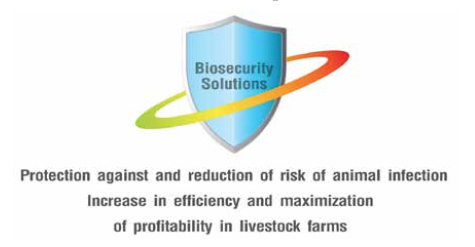In many cases, even though cleaning and disinfecting protocols are followed regularly on farms, diseases are still detected. Fortunately, Better Pharma has developed products and solutions to solve one of the most important issues in livestock farming today.
Biosecurity is the use of procedures or practices to protect livestock from harmful pathogens that cause illness and negatively affect growth performance. Biosecurity principles can prevent disease from entering a farm or spreading from farm to farm.
Biosecurity aims to reduce the probability of introducing (external) pathogens and allowing them to multiplying (internal) if they arrive. Thus, the key is to avoid transmission, whether it is between farms or within a farm.
Do you perform effective disinfection to reduce the pathogen load on your farm? Are you using appropriate disinfectants with the right contact time at all critical control points? Is the disinfection process thoroughly done at each step?

Let’s start with the four key success factors for biosecurity solutions
1. Reduce pathogen load.
Cleaning and sanitizing can bring pathogen levels down by up to 70%. The “dry” cleaning step involves brushing, scraping, sweeping and removing all bedding, feces, feed, dust and debris from the area. In dusty areas, moisten first to control dust and minimize aerosolization. Proper disposal of bedding, gross debris, dirt, and organic materials, such as manure, is important and may vary depending on location. The goal is to remove as much organic matter to the extent possible. The presence of organic materials can harbor microorganisms for long periods of time as well as protect them from the actions of chemical disinfectants. Cleaning is also important because many disinfectants may be inactivated or ineffective in the presence of organic matter.
Washing or sanitizing further reduces the number of microorganisms in the area to a safer level. This is the most crucial step in the disinfection process and will most likely eliminate the majority of remaining microorganisms, if performed correctly. Soak the area with water and detergent or other cleaning agent, then wash by wiping, spraying, or scrubbing. Application of washing solution can be improved by using a high pressure applicator. Afterwards, the washed areas should be left to dry out before applying the selected disinfectant to reduce potential dilution.
2. Critical control points must be thoroughly disinfected and cleaned:
Vehicles, personnel, animals, housing and equipment need effective detergents and disinfectants.
Vehicles: All vehicles that transport animals, especially those entering the farm, have the potential of spreading diseases. This may occur either by the vehicle itself or materials or dirt carried by the wheels. We recommend farms place wheel baths and spraying stations at the entrance of the farm.
Vehicles allowed to enter farms should be kept to a minimum. If possible, unloading should be done outside the farm area. Vehicles should also be cleaned and disinfected between farms. The vehicle should always be cleaned from top to bottom.
Also, be sure to wash the undersides of fender wells and the vehicle’s underbody and frame. Apply an appropriate disinfectant with a low-pressure sprayer and allow the proper contact time to elapse. The interior of the vehicle should also be thoroughly cleaned and disinfected before leaving the farm.
Personnel: Provision of boot baths and house spray should be standard practice. Proper contact time for disinfecting in the boot baths is equally important as cleaning premises and equipment. Boot baths should be replaced daily for best results.
3. Right disinfectant and correct contact timing for optimal efficacy:
An ideal disinfectant is one that is broad spectrum, works in any environment and non-toxic, non-irritating, non-corrosive and relatively inexpensive. Unfortunately, no disinfectant is ideal. Therefore, careful consideration of the characteristics of disinfectants is essential to get the most useful, effective and cost-efficient product.
Glutaraldehyde combined with Quaternary Ammonium Compounds (QACs) is a high-level broad spectrum disinfectant. Appropriate contact times are essential. Disinfectants may vary in the contact time needed to kill versus inactivate the microorganisms. Areas being disinfected should be well soaked with the disinfectant to avoid drying out before reaching the optimum contact time.
Foaming disinfectant offers longer contact times on surfaces for killing pathogens. This reduces the volume of disinfectant required by more than 60% (one litre of foaming disinfectant covers up to five square metres) and uses about 80% less water than ordinary disinfecting spray.
4. Wide coverage: water and feed contamination as well as pest control need to be assessed to ensure successful biosecurity.
Water used on farms could be a source for introducing pathogens. Most pathogens that follow a cycle of faecal-oral transmission can be water-bound. Therefore, the bacteriological content of water should be tested regularly, at least once a year.
Water systems, tanks and pipes should be cleaned and disinfected regularly because biofilm growth inside can harbor bacteria. Also, water treatment with chlorine or some other disinfectant such as iodine is an important tool in risk management
Feed could be contaminated with infectious agents, for example fungus, bacteria and viruses at numerous points throughout the manufacturing process, or exposed to contaminated ingredients and contaminants during receiving and transferring, cross-contamination at the feed mill, by delivery vehicles (both incoming and outgoing) and delivery personnel. Potential hazards should be identified, evaluated and prioritized.
Pest such as mosquitoes, flies, mites, lice, bed bugs, fleas and other insects are disease vectors. Pest control programs can reduce the risk of pathogens entering and spreading on farms.
To prevent the spread of disease, we recommend disinfection around the farm and on all feeder roads twice a day with disinfectant instead of carbonate because calcium carbonate is inactive in dry conditions.
Let’s create a flawless protection strategy for your farm with Better Pharma’s biosecurity solutions.

